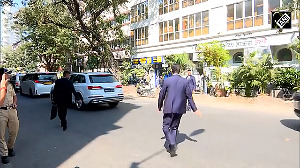It takes a festival for a city to reinvent itself.

In July, five million devotees will descend on Puri, one of the four places of worship that a Hindu must visit in his lifetime.
The occasion is the Nabakalebar festival when Jagannath, revered by millions as the lord of the world, takes a new form, exemplifying the principle of reincarnation, the cycle of birth and death.
The festival promises to transform Puri, a town in coastal Odisha of less than half-a-million people, according to the 2011 census.
Its infrastructure is getting a serious facelift, and its economy - hotels, restaurants, shops, rickshaw pullers and even priests - hope to do brisk business in the rush.
Above all, the festival is about Puri's resident deity, Jagannath. Nabakalebar, which literally means a new body, involves the replacement of the idols of Jagannath, Balabhadra, Subhadra and Sudarshan at the famous Jagannath temple with new ones.
It happens when there are two months of Ashadha in the Hindu calendar, like this year.
This happens once in every 12-19 years - the last Nabakalebar was held in 1996. The new set of deities is made from a special variety of neem (margosa) wood, which is locally known as Daru Brahma.
In the ceremony, not only are the idols replaced but "supreme power" too is transferred from the old to the new through secret rituals.
The exercise begins after a mid-day offering to Jagannath. A 12-foot garland called Dhanva Mala is especially prepared for the Lord and his siblings.
Post worship, the garland is handed over to the Pati Mahapatra family which leads the procession to Kakatpur, 50 km away where the Maa Mangala temple is located.
(En route, the procession halts at the palace of the former king of Puri.)
The eldest Daitapati (servitor) sleeps inside the temple, and in his dream, the Goddess is supposed to inform him about the exact location of the neem trees.
These are no ordinary neem trees. Since Jagannath is dark, the tree from which his idol is to be carved also has to be dark.
However, as Jagannath's siblings are fair, the wood for their idols should be light in colour.
The Jagannath tree should have four principal branches, symbolising the four arms of Narayana. There must be a water body near the tree as well as a cremation ground and an anthill.
At the root of the tree there has to be a snake pit.
No bird must have made nests in the tree; and no branch should be broken or cut.
The tree has to be located near a three-way fork on the road or should be surrounded by three mountains.
No creepers must have grown on the tree and there have to be Varuna, Sahada and Bilva trees (these trees are not very common) close by.
Finally, there has to be a Shiva temple in the vicinity.
Once the trees are identified, at an auspicious moment, accompanied by sacred chants, they are felled.
The logs are then brought to the Jagannath temple in chariots by the Daitapatis for carving.
The transformation ceremony takes place three days before the celebrated Rath Yatra, when the 'Brahman' or the life force (also referred to as pinda) is transferred from the old deities to the new.
The transformation is guided by a set of rules: the designated Daitapatis are blindfolded, a piece of cloth binds their hands before the transfer begins and they are not allowed to shave after the first day of the search procession.
At midnight, the old idols of the deities are carried by the Daitapatis on their shoulders and buried before dawn, a ritual that nobody can witness, or else he is destined to die. For this reason, the state government carries out a full power blackout on this night in the entire town of Puri.
The following morning, the new deities are seated on the altar titled 'Ratna Singhashana'.
The date for this event is July 16.
Two days later, it will culminate in the great chariot ride of the deities.
Thereafter, it will be business as usual for the temple after a gap of 58 days.
For some rationalists, all this might look obscurantist.
But for people in Puri, their faith in Jagannath is supreme -- so supreme that the state is leaving no stone unturned to ensure that the whole festival happens without a glitch.
The gathering of this scale needs elaborate bandobast: passenger amenities, uninterrupted electricity and proper sanitation.
The budget for these public works is close to Rs 2,000 crore.
A big chunk of this investment is going into the revamp of Puri's power system.
"A special power grid is being installed at Samagara village, close to the town along the Puri-Konark Marine Drive.
An underground power cable network is being laid to ensure that it will be resistant to natural disasters like cyclones," says energy secretary and special administrator, Jagannath Temple (Puri), Suresh C Mohapatra.
Apart from that, the 67.25 km road from Bhubaneswar to Puri is being expanded, a new bus terminal at Malatipatapur is being constructed, 20 parking places for two- and four-wheelers are being earmarked, and seven overhead water tanks are being built.
Keeping in view the Nabakalebar festival, East Coast Railway has proposed the construction of a new shed at Puri.
Construction of two additional platforms is under way at Bhubaneswar.
East Coast Railway has also proposed a modern station at Bhubaneswar with increased area for passenger amenities at a cost of Rs 80 crore.
The Odisha government has agreed to provide Rs 40 crore for this project.
Other ongoing works include augmenting line capacity on the Cuttack-Bhubaneswar-Khurda-Puri rail line and a third line on the Khurda-Bhubaneswar-Barang route.
Chief Minister Naveen Patnaik has deployed an army of senior bureaucrats to oversee the progress.
He has asked the Puri district administration to gear up for the event and come out with standard operating procedures in case of incidents like stampedes, fires and diseases that may arise because of the massive congregation.
Health Minister Atanu Sabyasachi Nayak says the state government has planned at least 500 additional beds in different hospitals in and around Puri, 100 first aid centres and 120 ambulances.
In addition, over 900 paramedic staff will be deployed to provide health services to the devotees.
It is going to be a test of Patnaik's administrative skills.
Such a large event can be a security nightmare.
To cope with it, the authorities have decided to provide a five-layer security cover for Puri.
Close-circuit televisions will be installed at strategic locations in the town like Grand Road (the venue of the Rath Yatra), the bus terminal, railway station, pilgrim shelters and parking lots.
A central security unit will be deployed for the festival. This unit will be equipped with bullet-proof four-wheelers and satellite phones, besides sophisticated arms and ammunitions.
For effective crowd management, 30 large digital screens will be installed at various points in the city and a traffic control unit will operate from a special facility at the Kumbharpara police station complex.
Puri is a coastal town, which exposes it to sea-borne terror attacks, the kind Mumbai witnessed in November 2008.
Thus, before the festival commences, the four marine police stations at Astaranga, Ramchandi, Chakratirth and Arakhkuda will be made fully operational with all state-of-art gadgets and adequate staff.
Two interceptor boats will patrol the Puri coastline.
For security concerns, the state government is also contemplating requesting the Union ministry of civil aviation to declare the air space over Jagannath Temple a 'no-fly zone'.
"Security inside the temple premises is being tightened using ultra-modern systems," says Odisha Director General of Police Sanjiv Marik. Baggage scanners will be installed at entry points to the Jagannath Temple.
Will this be good enough?
Talking on the preparedness for Nabakalebar, Jagannath Swain Das Mahapatra, servitor at Jagannath Temple, says, "The last edition of Nabakalebar in 1996 was a huge success without any untoward incident and we are aiming for a similar arrangement this time." While 2 milllion people visited Puri then, this time the visitors are expected to more than double to 5 million.
According to Odisha Law Minister Arun Sahu, efforts are on a war footing and all works, including construction of roads, parking places, sewerage, water supply and temporary kiosks for doctors, would be completed by June, a month before the festival kicks off.
An event of such scale is bound to generate some political heat. Many in Odisha complain that Union Finance Minister Arun Jaitley made no allocation for the Nabakalebar festival in the Budget for 2015-16.
Odisha had submitted a proposal to the erstwhile Planning Commission, demanding special central assistance of Rs 740 crore for development works since the Commission had provided support of Rs 800 crore for organisation of the Kumbh Mela at Varanasi in 2013.
The state has been left to its own devices.
Within Odisha, the Opposition has debunked the government's claims on security arrangements and infrastructure works. "This government is not serious about the preparedness for Nabakalebar.
Going by the pace of work, it seems the government will not be able to complete different projects before the ceremony," state Congress President Prasad Harichandan said recently at a press meet.
Local business is, of course, thrilled at the prospects. Asked about the earnings that could accrue during the festival, Ashok Panda, Odisha's minister for tourism and culture, says that, on an average, a domestic tourist spends Rs 1,357 per day and an overseas tourist Rs 2,255 during their stay in the state. With 5 million people expected to congregate for the festival, the tourism earnings can run into hundreds of crores.
"The non-resident Indians from the state based in USA, Britain, Australia can be tapped for business in the Nabakalebar festival.
It is an opportunity to establish contact with these communities.
"There has been a surge in enquiries," says Benjamine Simon, managing director, Travel Link, and chairman (Odisha chapter), Indian Association of Tour Operators.
"Within the country, Odisha has links with Bengaluru, Gujarat and Hyderabad.
"Other places like Delhi, Chennai and Mumbai can also be targeted.
"Puri being one of the char dhaams (the four places of pilgrimage), pilgrims from the other dhaams (Badrinath in the north, Dwarka in the west and Rameswaram in the south) are likely to rush to the temple town during the holy event."
Almost 75 per cent of the visitors will be from within the state. Guides, shopkeepers, restaurants, artisans, rickshaw pullers, auto rickshaws are also set to get lucrative business during Nabakalebar, according to Simon.
"We are expecting 100 per cent occupancy in the hotels, dharmashalas, ashrams and holiday homes. It is an opportunity to bag businesses," says R K Das Mohapatra, president of Hotel Association of Puri.
The temple town has about 480 hotels, 200 lodgings, 12 dharamshalas, 80 ashrams and more than 100 holiday homes.
They all have to thank Lord Jagannath for the windfall that awaits them.
Nirmalya Behera contributed to this report.
Photograph: Jayanta Shaw/Reuters










